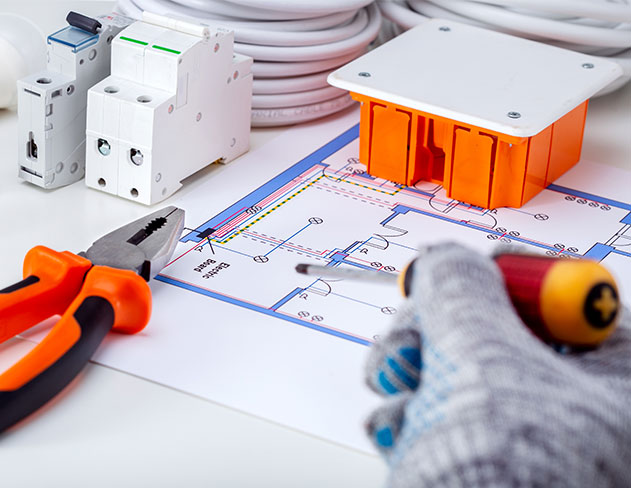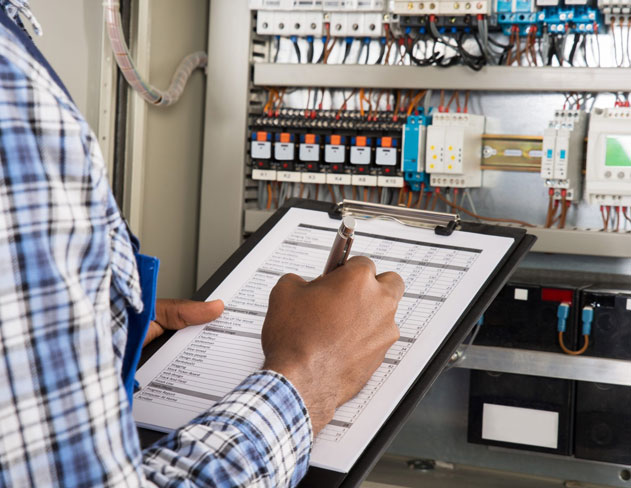Why bother which items need to be PAT tested? When appliances and devices are not properly tested and inspected, it can lead to electric shocks, fires, damage, and even loss of life. That’s why identifying which items require PAT testing should be a top priority.
This guide will provide an overview of PAT testing, highlight the kinds of appliances and devices that need regular inspections, and offer recommendations on testing frequency. Following proper PAT procedures can prevent electrical faults, reduce liability, and save lives.
The Essence of PAT Testing
What is PAT Testing?
For portable appliance testing, PAT testing routinely checks electrical appliances and equipment for any issues that could cause electric shocks or fires. It involves visually inspecting the appliance and actual testing using a PAT tester device.
Qualified professionals use PAT testers to check for electrical safety issues like damaged cords, incorrect wiring, inadequate earthing, and other faults. The testing ensures that electrical appliances are safe to continue using.
Why is it Crucial?
Regular PAT testing is a legal obligation for landlords and businesses under the Electricity at Work Regulations. For homeowners, while not strictly required by law, it is vital to keeping your family safe.
Appliances that seem perfectly normal could still harbour electrical faults and hazards. Over time, damage can occur to the casing, cables, plugs, and internal components. Testing identifies problems early, before they cause any incidents. Ensuring electrical safety is well worth the small time and cost investment.
Home Appliances and Devices
Kitchen Appliances
Kitchen appliances endure heavy daily usage and require diligent PAT testing to identify potential electrical faults early.
Microwaves contain powerful magnetrons that can malfunction and leak harmful radiation. Older units lack safety cut-off switches. Built-up grime and food splatter can also overload components. Testing ensures shields and seals prevent leakage.
Toasters experience heavy load from heating coils and high current draw. Crumbs accumulating in nooks present a severe fire hazard. Testing verifies no loose connections or deteriorated wiring insulation.
Blenders contain robust motors with high-speed moving parts. Leaks allow moisture seepage leading to dangerous short circuiting. Testing confirms watertight casing and grounding.
Kettles routinely heat up rapidly, which strains wiring and connections. Mineral buildup degrades heating elements, and steam corrodes internals. Testing checks for overheating, leaks and component wear.
Ovens operate at extremely high temperatures which accelerate insulation breakdown. Short circuits can spark dangerous arcs. Testing detects hotspots and faults before fires erupt.
Entertainment and Leisure
Entertainment appliances in living areas harbour hazards from dust, heat and mishandling:
Modern TVs seem sleek but still require testing. Faulty capacitors overheat, power surges damage circuits, and old CRT TVs emit x-rays. Careful inspection locates flaws.
Gaming consoles pack powerful processors generating intense heat in compact cases. Cooling fans fail over time. Testing ensures proper ventilation and thermal safety.
Sound systems draw high current and operate hot. Testing confirms sufficient gauge wiring and heat dissipation. Short circuits in amplified speakers could spark fires.
DVD players contain laser units with exposed live voltage. Dust accumulation causes overheating and seized motors. Testing identifies wear before malfunctions occur.
Personal Care Devices
Handheld personal care devices undergo constant physical stress in bathrooms:
Hairdryers endure overheating elements and clogged air vents. Internal wiring wears from twisting and bending. Testing verifies grounding and durability.
Straightening irons reach 400°F. Plates may detach if adhesive fails and cause burns. Testing ensures auto-off and safe operation.
Electric razors vibrate vigorously promoting solder joint failure. Testing checks for loose components and water sealing. Leaks cause short circuiting.
Toothbrushes harbour lithium batteries that can leak, ignite and explode. Chargers may overheat and melt. Testing prevents hazardous malfunctions.
Business/Workplace Equipment
Electrical safety is more important in workplace environments, where heavy equipment and industrial hazards are present daily. Performing thorough PAT testing helps identify risks before any accidents occur.
Office Electronics
Shared printers, computers and other office electronics endure near-constant use from multiple employees. The heavy strain means PAT testing should occur frequently:
- Computers – Testing thoroughly checks cables, power supplies and internal components for deterioration. Surges damage delicate circuits. Dust and debris cause overheating when ventilation is obstructed.
- Photocopiers – High voltage components pose major shock hazards for staff. Toner dust accumulation causes overheating and potential ignition. Testing confirms proper grounding, leak protection and automatic shut-offs.
- Fax machines – Testing carefully checks solder joints on circuit boards, which weaken over time from vibrations during operation. Loose connections severely compromise safety.
- Projectors – The intense heat from high-powered bulbs can ignite nearby objects. Testing ensures adequate ventilation, cooling and isolation from flammable materials.
Industrial Tools and Machinery
Workshop and factory tools endure intense strain in hazardous conditions. Diligent PAT testing is vital:
- Power drills – Testing thoroughly checks power cords for nicks and integrity. Metal shavings entering the casing can cause dangerous shorts. Internal wear is common from prolonged heavy use.
- Saws – The rapid vibrations of saw blades loosen components over time. Testing verifies blade guards, switches, emergency stops and other safety mechanisms function properly before failures cause injuries.
- Welding machines – Testing ensures arc welding equipment has proper shielding. Stray UV radiation causes severe burns. Sparks ignite flammable materials.
- Conveyor belts – Testing meticulously checks the reversing and emergency stop circuits which prevent serious crushing accidents. Belts torn by heavy loads can also cause hazards.
Retail and Service Equipment
Retail stores and service businesses contain equipment used by both staff and customers. Careful PAT testing is crucial:
- Cash registers – Testing checks for voltage fluctuations and surges which are common and cause malfunctions. Overloading peaks during busy periods strains components.
- Barcode scanners – Testing ensures continued seamless operation for checkout processes. Delayed scans quickly frustrate customers. Internal faults halt sales.
- Security systems – Testing confirms backup power and reporting functions remain failsafe. False alarms disrupt business activities and impact credibility.
Special Considerations for Certain Devices
While all electrical equipment needs periodic PAT testing, certain devices pose unique risks that require more frequent and diligent inspection.
Second-hand Appliances
Used appliances purchased from classifieds, thrift stores or garage sales require immediate testing before use, regardless of age or condition. You can never be sure of their full history:
- Internal components may be damaged or severely outdated, making them prone to deterioration and unsafe operation.
- Makeshift repairs by previous owners raise major safety concerns, since no documentation exists on the work done.
- Appliances likely endured heavy usage patterns, shortening their expected lifetime. Hidden defects are highly probable.
- Older units lack modern safety features like grounded plugs, surge protectors and leak prevention. Using them as “as-is” poses major risks.
Frequently Moved Devices
Portable electrical equipment that undergoes frequent movement should be tested regularly to identify wear:
- Laptops experience near-constant transport, which strains and damages cords and plugs through twisting and bending.
- Portable heaters undergo vibration damage from frequent relocation. Jostling loosens internal parts over time.
- Extension cords suffer abrasion and fraying from repeated handling, twisting and traction during movement.
Older Devices
Vintage electrical devices warrant testing for outdated and hazardous components:
- Antique radios utilise now-obsolete vacuum tubes that degrade and require replacement for safety.
- Old CRT televisions contain extremely high voltage parts that pose major electric shock risks from any malfunctions.
- Heirloom appliances lack modern safeguards like three-prong grounded plugs, voltage regulators and surge protectors. Using them as “as-is” is very dangerous.
While such devices hold nostalgic and decorative value, electrical safety should take utmost priority over originality and period correctness.
How Often Should Items Be PAT Tested?
Performing PAT testing at appropriate intervals is vital for ongoing electrical safety. Frequency depends on equipment type and usage levels.
High-risk Devices
Appliances with known issues or in high-use settings require monthly testing, including:
- Devices with a history of previous faults.
- Equipment exposed to moisture or vibration damage.
- Appliances in commercial kitchens and factories.
Stationary vs. Portable
Stationary devices require 6-12 month testing, while portable equipment needs 3-6 month inspections:
- Stationary items aren’t subject to cord and plug strain from movement.
- Portable appliances undergo more wear from transport and handling.
New Purchases
Brand new appliances should ideally be tested before first use:
- Manufacturing defects may elude quality control and be undetected.
- Appliances may sustain damage during shipping and installation.
Inspecting new purchases verifies safety before exposing your family and home.
Key Takeaways
The Right Items
Carefully evaluating your space identifies which devices absolutely require testing for peace of mind. Don’t ignore appliances that seem harmless.
Make PAT Testing Non-Negotiable
Regular electrical inspections must become a non-negotiable part of home and workplace safety protocols. The risks are too high to overlook.
In summary, correctly identifying which devices warrant PAT testing helps maximise safety for yourself and others who occupy the space.Combining visual inspection with thorough electrical testing verifies the integrity of appliances and equipment, identifying faults before catastrophe strikes.
Making PAT testing a habitual routine enhances electrical safety for your home or business.

